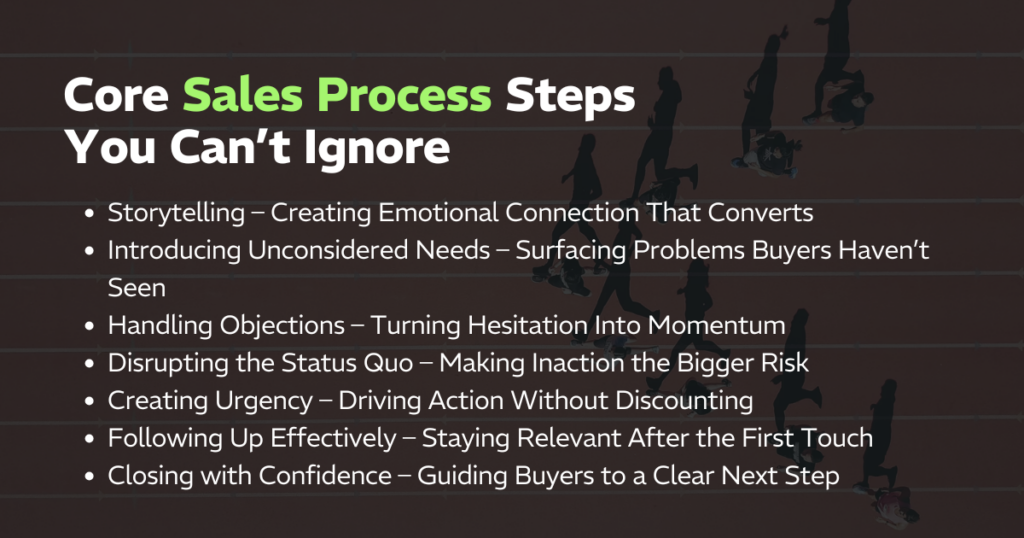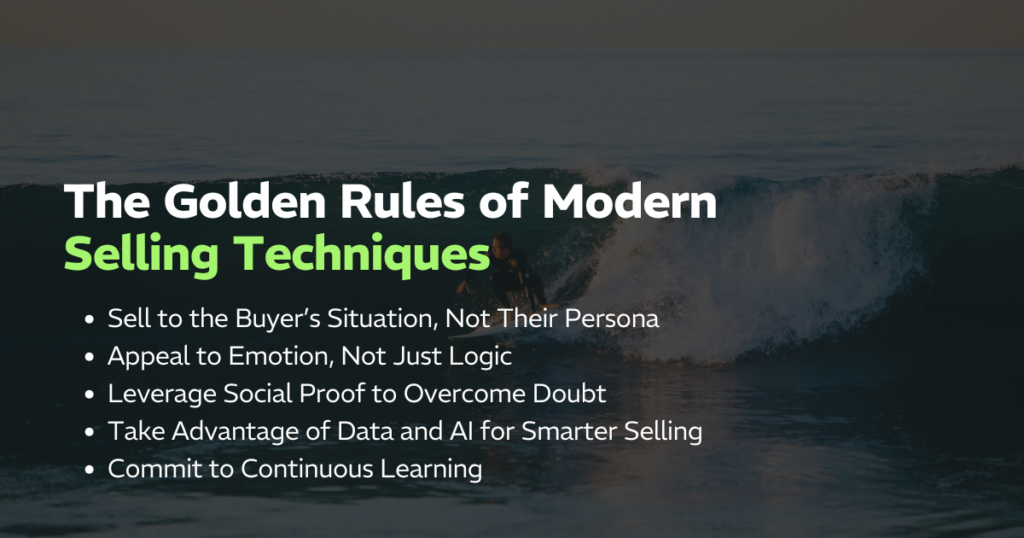Modern sales techniques aren’t about pressure or persuasion. They’re about value, trust, and relevance.
Over the years, I’ve worked with thousands of top sales professionals. The best don’t follow a script. They follow a mindset—one built on curiosity, empathy, and a relentless focus on the customer’s success. They understand that the best sales pitch is rooted in listening, adapting, and providing tailored solutions that solve real problems.
It starts with the fundamentals: refining your sales techniques and strategies, building trust from the very first touchpoint, and understanding where your product or service fits into your buyer’s world.
High-Impact Modern Sales Techniques That Drive Results
There’s a moment in every sales conversation when the dynamic shifts. The prospect stops politely nodding and starts leaning in. You’re no longer just delivering a pitch—you’re solving a problem, offering clarity, leading. That’s the moment every great seller lives for.
But getting there? It’s harder than ever.
Today’s buyers show up with more information—and more skepticism. They’ve done the research. They’ve compared solutions. They’re not just looking for features. They’re looking for a partner they can trust to guide them to better outcomes.
There’s no one-size-fits-all approach anymore. The most effective sales techniques recognize that the sales cycle is rarely linear. Every buyer has their own decision-making process, pain points, and priorities.
If you’re selling into B2B sales environments, your sales strategy and sales process is going to look different than a transactional B2C interaction. Decision makers are busier. The stakes are higher. The buying process is more complex. And your sales approach has to reflect that.
SPIN Selling – The Power of Problem-Solving
SPIN—Situation, Problem, Implication, Need-Payoff—has stood the test of time because it puts the focus exactly where it should be: on the buyer.
When reps ask thoughtful questions, they’re not just gathering intel—they’re helping the buyer think differently. The deal closes itself when the buyer connects the dots and realizes the cost of inaction.
This is a powerful tactic in complex B2B sales cycles, especially when you’re dealing with multiple stakeholders who need help clarifying the root issue.
SNAP Selling – Selling to the Short-Attention-Span Buyer
We all know this buyer: they’re over-scheduled, distracted, and under pressure. If you don’t earn their attention quickly, you’ll lose them.
SNAP—Simple, iNvaluable, Aligned, Priorities—reminds us to keep it crisp and clear. Your ability to cut through the noise with value is the key to getting on their calendar and staying in their consideration set.
Value-Based Selling – Sell Outcomes, Not Features
Nobody buys a feature. They buy a result. A transformation. A win.
I see too many reps stuck in demo mode. Instead, shift the conversation to ROI. When you can show a buyer how your solution drives outcomes, you move from vendor to trusted advisor. That shift is the heart of customer value in sales.
Effective value-based selling requires more than just benefits. It demands a deep understanding of your buyer’s business model—and the confidence to frame your product or service as essential to achieving their goals.
Consultative Selling – Asking the Right Questions
When I think about the best sellers I’ve coached, they all have this in common: they listen more than they talk.
Consultative selling is about asking the kinds of questions that make buyers pause and reflect. It’s how you move from qualifying to partnering. This style of selling is rooted in active listening and the ability to map insights to real needs. You’re not there to pitch—you’re there to help the buyer solve their problems.
The Challenger Sale – Teach, Tailor, Take Control
Sometimes the best thing you can do for a buyer is challenge their thinking.
Great salespeople bring new insights to the table. They help buyers see the world—and their problems—differently. That confidence builds trust. It also positions you as a strategic partner who understands the broader business implications, not just product specs.
Relationship Selling – The Trust-Building Advantage
Deals may close on paper, but they’re built on trust. Building relationships is still one of the most effective sales techniques for long-term success.
In an age of automation and cold calling, showing up with empathy and consistency is your differentiator. That kind of presence is at the core of strong sales presentation skills.

Core Sales Process Steps You Can’t Ignore
Before any specific sales technique can make an impact, these foundational steps have to be in place. They aren’t what win you the deal—but without them, you’re not even in the game.
This is the structure beneath every effective sales approach. These steps show up in every sales cycle, whether you’re pitching a new product or managing a long-term client relationship. Get them right, and your techniques have a chance to shine.
Storytelling – Creating Emotional Connection That Converts
Facts inform. Stories inspire. Storytelling connects emotionally, builds credibility, and helps your buyer see themselves succeeding with your solution.
Whether you’re selling a service or product, your story should speak directly to your buyer’s goals and pain points.
Introducing Unconsidered Needs – Surfacing Problems Buyers Haven’t Seen
Buyers don’t always know what they need.
When you surface an unconsidered problem—and connect it to a business risk—you earn the right to offer a solution. This sales tactic turns passive interest into urgent action.
Handling Objections – Turning Hesitation Into Momentum
Objections are part of the sales process. And how you handle them says everything about your credibility.
They’re signals that the buyer is engaged. Be ready to reframe, refocus, and reinforce your value.
- “It’s too expensive.” → Let’s walk through the ROI.
- “I need to think about it.” → Here’s what others in your shoes have done.
- “We’re working with someone else.” → Let me show you where we’re different.
Disrupting the Status Quo – Making Inaction the Bigger Risk
One of the biggest threats to any deal isn’t a competitor—it’s inaction. Many buyers stay stuck in the status quo.
Your job is to show them what’s possible when they choose to move—and what they risk by staying put.
Creating Urgency – Driving Action Without Discounting
Discounting is easy. But it can also devalue your product.
The more powerful approach is to create urgency by tying your offer to timing, exclusivity, or missed opportunity. Show them what they lose by waiting.
Following Up Effectively – Staying Relevant After the First Touch
It’s not the first touch that closes the deal—it’s what happens next.
Most deals are won (or lost) in the follow-up. Great sales reps stay top of mind with consistent, relevant touchpoints that build momentum.
Closing with Confidence – Guiding Buyers to a Clear Next Step
If you’ve done the work—built trust, uncovered needs, communicated value—then the close should feel like a natural next step.
Don’t hesitate. Don’t overcomplicate. Make the ask.

The Golden Rules of Modern Selling Techniques
There are techniques that help you win the moment—and then there are principles that help you win for the long haul. The following rules aren’t tied to one pitch or one deal. They’re what the best sales professionals return to again and again, no matter how the market shifts or how complex the buyer’s journey becomes.
These ideas are the foundation of a modern sales mindset. And when your entire sales team is grounded in them, everything else gets easier—building trust, moving through the sales cycle, and becoming the kind of advisor buyers want on their side.
Sell to the Buyer’s Situation, Not Their Persona
Forget assumptions. Focus on what’s actually happening in their world. That’s what makes a sales approach effective.
The best reps are adaptive. They tailor every conversation to fit the moment.
Appeal to Emotion, Not Just Logic
We like to think decisions are rational. But we buy based on emotion and justify with logic.
Tap into what your buyer cares about. Align your message with their values—not just their goals.
Leverage Social Proof to Overcome Doubt
No one wants to go first. Social proof gives your buyer the confidence to act.
Bring in case studies, success stories, and referrals. Show them they’re in good company.
Take Advantage of Data and AI for Smarter Selling
Modern sales teams aren’t guessing. They’re using insights to lead the way.
From CRM data to predictive tools, technology helps reps prioritize effectively, personalize outreach, and streamline the sales process. That’s where the impact of AI on sales becomes a real differentiator—giving sales teams the intelligence and efficiency to personalize every step of the process.
Commit to Continuous Learning
Sales is changing. Fast. What worked yesterday won’t always work tomorrow.
The top performers in every organization are the ones committed to learning, growing, and pushing their edge. It’s why learning agility in sales should be a core part of every rep’s growth strategy.

Master Advanced Sales Techniques
The fundamentals matter. But if you want to go from good to great, you need to elevate every part of your game—from how you open a cold call to how you build trust during discovery to how you adapt your sales pitch in real time.
Every touchpoint in the buying process is a chance to reinforce value, build connection, and move the deal forward. That’s what modern sales is all about.
Sharpen your team’s sales techniques and close more deals.










